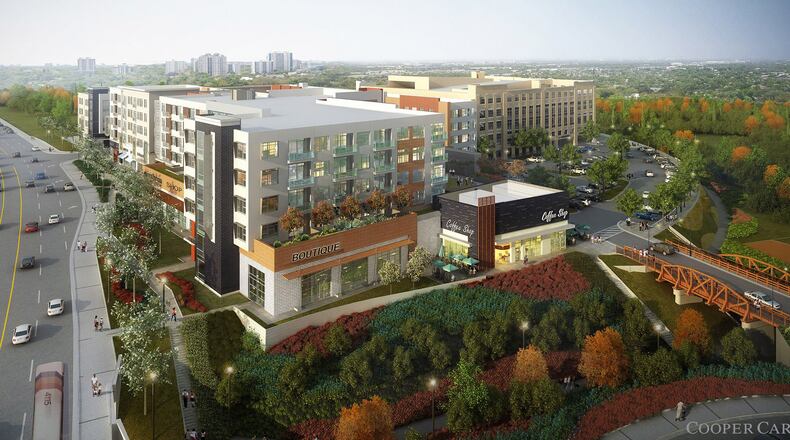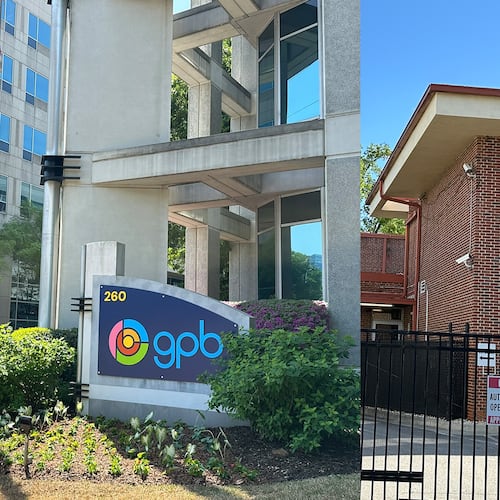Parking lots around the Brookhaven MARTA station might soon give rise to a blend of apartments, shops and office space that will create a decidedly urban feel.
Forgotten parcels near the Chamblee station are slated for mid-rise apartments and the ultimate emblem of yuppie status, a Whole Foods market. At the end of the Gold Line in Doraville, the hulking former General Motors plant is now rubble, with developers planning a film studio and what would amount to a new downtown in its place.
The northeast leg of MARTA’s rail line is on the verge of massive transformation that would remake an overlooked swath of car-centric suburbs into a string of urban villages with town centers and transit. It’s not unlike the surge of development seen in Midtown or along the Beltline, or the rejuvenation of Decatur.
A defining feature this time is MARTA, which has moved from being a political punching bag to a lure for private investment and economic development.
Many of the region’s headline development deals and corporate re-locations of late are near MARTA stations in Midtown, Buckhead and the Central Perimeter. Now it’s the Gold Line and the close-in suburbs of Brookhaven, Chamblee and Doraville receiving a new rush of investment.
INTERACTIVE MAP AND SLIDESHOW OF GOLD LINE PROJECTS
That development has happened in part because of demographic shifts and changes in consumer tastes, as well as the prolonged recovery, experts said. Both millennials and boomers want more walkable settings with transit access.
But cheaper and available land in these neighborhoods also has caught the eyes of developers looking for new sections of the metro area to build. MARTA officials hope to be a catalyst, with plans to lease land at the Brookhaven and Chamblee stations for private development.
“Generally in Atlanta, you are seeing a drive toward in-town living,” said Amanda Rhein, MARTA’s senior director of transit oriented development and real estate. She said Brookhaven and “Chamblee in particular represent a great opportunity to be in a walkable urban environment that’s not as expensive of other in-town markets.”
The agency is vetting proposals for a mix of offices, residences and retail from developers for 15 acres of develop-able property at its Brookhaven/Oglethorpe University station. A 2-acre parcel adjacent to the Chamblee station is being considered for office and residential.
Growing appeal
Doraville and Chamblee didn't see as much of the boom of other communities pre-recession, but they've shown signs of growing appeal coming out of it.
In Chamblee, the population grew 3 percent from 2010 to 2013, and median household income is up 6 percent in that time, according to U.S. Census data. In Doraville, bludgeoned by the loss of the GM factory in 2008, population and household incomes increased 20 percent and about 3 percent, respectively, in that time.
Ride the train northeast past Buckhead’s Lenox Square into Brookhaven and signs of development interest abound.
The Dresden Drive corridor is now a bustling hub of restaurants and mid-rise apartments. The Town Brookhaven development, which opened during the early days of the recovery, just added its third apartment development. Next door, Gables Residential is building a student housing project with classrooms that’s tied to Oglethorpe University.
MARTA has several projects underway across its network to lease underused land or parking lots to developers to convert into mixed-use communities. MARTA officials see the market being ripe for the Brookhaven and Chamblee stations. The goal is to generate revenue from the leases, as well as new riders.
Though it might not have as much office space as the Lindbergh station — perhaps MARTA’s best known “transit-oriented development” — Rhein said the Brookhaven site could feature similar apartment density.
“There are a number of different factors we weigh when we consider if property is ready for development,” Rhein said, such as the investment climate, usage of its parking lots and whether the station can support the loss of parking to accommodate new development as well as the infrastructure of the surrounding area.
Development interest spans beyond MARTA-controlled properties.
In Chamblee, the Spruce Street Partners development firm has pitched Parkview on Peachtree near the city’s Walmart plaza that would include about 500 residences in two phases. The project also calls for loft office space for tech firms and smaller private companies and ground-floor restaurants and boutiques. The vacant property once was slated for an office park.
Trail network
An existing trail network that one day will link the cities of Brookhaven, Chamblee, Dunwoody and Doraville already connects the project to the Chamblee MARTA station.
The Parkview project, which is expected to open its first phase in 2017, will have company from The Olmsted Chamblee, a 283-unit apartment development that also will have retail space. A few blocks away, a Whole Foods grocery store will anchor developer S.J. Collins’ Peachtree Crossing where Peachtree Road splits from Peachtree Industrial Boulevard.
In Doraville, the 165-acre GM site has become a hoped-for lifeline that could return thousands of jobs to the former manufacturing center.
The development team led by Atlanta-based Integral Group has largely demolished the plant. Third Rail Studios, a film-making campus, is planned for a portion of the site, and Integral is trying to woo corporate headquarters to a campus that will feature parks streams and a walkable street grid. A covered street lined with shops will connect the complex to the transit station.
Jack Halpern, a noted metro Atlanta retail developer and chairman of the Doraville Downtown Development Authority, said Doraville developed into a prosperous middle class city with the GM plant in the 1950s and 1960s, but it also got hemmed in and divided by rail lines and interstates. Growth stagnated.
High hopes
The GM site redevelopment, he said, will be a “game changer” for the city. Commuters already drive to Doraville to hop on the train to Atlanta or the airport. But at quitting time, they head home.
The new development could bring thousands of workers and residents to the city, he said.
Doraville, one of the most diverse cities in Georgia, has a vibrant international business community. The challenge will be to ensure those businesses thrive and aren’t uprooted by the growth. Halpern said he thinks the Assembly project, which the GM site is now called, and another planned on a former Kmart site just north of I-285 will boost the city’s existing businesses.
There are few development sites as large as the Assembly site remaining inside the Perimeter, said Eric Pinckney, an executive with the Integral Group. The Doraville site is close to booming suburbs like Dunwoody and Brookhaven that are urbanizing and running out of large parcels.
“We know certain trends work in our favor — the trend toward transit, the trend toward urbanization and the continued trend (of migration) toward the Sun Belt,” Pinckney said. “(There’s) healthy real estate and active real estate all around it. And (development) is running out of places to go.”
About the Author
Keep Reading
The Latest
Featured




